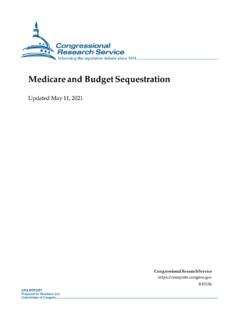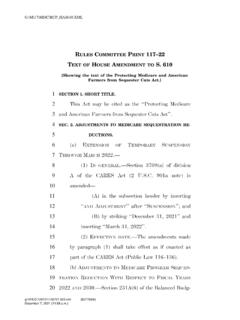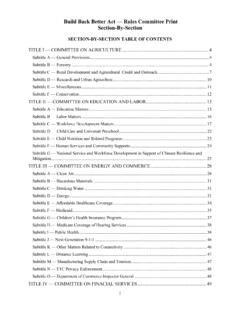Transcription of SPINAL CORD STIMULATION COMMONLY BILLED CODES
1 1 SPINAL Cord STIMULATION COMMONLY BILLED CODES 2022 2 TABLE OF CONTENTS ICD-10-CM Diagnosis 3 ICD-10-PCS Procedure 6 HCPCS II Device CODES (Non- medicare ).. 7 Device C- CODES ( medicare ).. 7 Device Edits ( medicare ).. 8 Physician Coding and 9 Hospital Outpatient Coding and 12 Hospital Inpatient Coding and 16 ASC Coding and 19 SPINAL CORD STIMULATION COMMONLY BILLED CODES 3 Medtronic provides this information for your convenience only. It does not constitute legal advice or a recommendation regarding clinical practice. Information provided is gathered from third-party sources and is subject to change without notice due to frequently changing laws, rules and regulations. The provider has the responsibility to determine medical necessity and to submit appropriate CODES and charges for care provided.
2 Medtronic makes no guarantee that the use of this information will prevent differences of opinion or disputes with medicare or other payers as to the correct form of billing or the amount that will be paid to providers of service. Please contact your medicare contractor, other payers, reimbursement specialists and/or legal counsel for interpretation of coding, coverage and payment policies. This document provides assistance for FDA approved or cleared indications. Where reimbursement is sought for use of a product that may be inconsistent with, or not expressly specified in, the FDA cleared or approved labeling (eg, instructions for use, operator s manual or package insert), consult with your billing advisors or payers on handling such billing issues. Some payers may have policies that make it inappropriate to submit claims for such items or related service.
3 The following information is calculated per the footnotes included and does not take into effect medicare payment reductions resulting from sequestration associated with the budget Control Act of 2011. sequestration reductions went into effect on April 1, 2013. ICD-10-CM1 Diagnosis CODES Diagnosis CODES are used by both physicians and hospitals to document the indication for the procedure. SPINAL cord STIMULATION therapy is directed at managing chronic, intractable pain. Pain can be coded and sequenced several ways depending on the nature of the encounter and the documentation. Pain CODES from the G89 series are used as the principal diagnosis when the encounter is for pain control or pain management, rather than for management of the underlying condition. When a patient is admitted for insertion of a neurostimulator for pain control, the G89 pain code is sequenced as the principal Additional CODES may then be assigned to identify the underlying cause and give more detail about the nature and location of the pain.
4 When the encounter is for a procedure aimed at treating the underlying condition and a neurostimulator is also inserted for pain control, the underlying disorder is assigned as the principal diagnosis. However, an encounter specifically to insert a neurostimulator is most common. Chronic Pain Disorders Central pain syndrome Other chronic pain Chronic pain syndrome Note: Pain must be specifically documented as chronic to assign code To assign code , the documentation must specifically state either chronic pain syndrome or chronic pain associated with significant psychosocial dysfunction. Similarly, central pain syndrome is a diagnosis and must be specifically documented to assign code Reflex Sympathetic Dystrophy (RSD) (Complex Regional Pain Syndrome I, CRPS I) Complex regional pain syndrome I of right upper limb Complex regional pain syndrome I of left upper limb Complex regional pain syndrome I of upper limb, bilateral Complex regional pain syndrome I of right lower limb Complex regional pain syndrome I of left lower limb Complex regional pain syndrome I of lower limb, bilateral Note: ICD-10-CM does not have a default code for Complex Regional Pain Syndrome ; type I or II must be specified.
5 Pain CODES from the G89 series should not be assigned separately with the CODES for reflex sympathetic dystrophy because pain is a known component of this disorder. FOR QUESTIONS PLEASE CONTACT US AT SPINAL CORD STIMULATION COMMONLY BILLED CODES 4 ICD-10-CM1 Diagnosis CODES continued Causalgia (Complex Regional Pain Syndrome II, CRPS II) Causalgia of unspecified upper limb Causalgia of right upper limb Causalgia of left upper limb Causalgia of bilateral upper limbs Causalgia of unspecified lower limb Causalgia of right lower limb Causalgia of left lower limb Causalgia of bilateral lower limbs Note: ICD-10-CM does not have a default code for Complex Regional Pain Syndrome ; type I or II must be specified. Pain CODES from the G89 series should not be assigned separately with the CODES for causalgia because pain is a known component of this disorder.
6 Arachnoiditis Chronic meningitis Meningitis, unspecified Peripheral Neuropathy of the Extremities Unspecified mononeuropathy of unspecified upper limb Unspecified mononeuropathy of right upper limb Unspecified mononeuropathy of left upper limb Unspecified mononeuropathy of bilateral upper limbs Unspecified mononeuropathy of unspecified lower limb Unspecified mononeuropathy of right lower limb Unspecified mononeuropathy of left lower limb Unspecified mononeuropathy of bilateral lower limbs Epidural Fibrosis Meningeal adhesions ( SPINAL ) (cerebral) Diabetes mellitus due to underlying condition with diabetic polyneuropathy Diabetic Peripheral Neuropathy3 Drug or chemical induced diabetes mellitus with neurological complications with diabetic polyneuropathy Type 1 diabetes mellitus with diabetic polyneuropathy Type 2 diabetes mellitus with diabetic polyneuropathy Other specified diabetes mellitus with diabetic polyneuropathy Radiculopathy Cervical disc disorder with radiculopathy, unspecified cervical region Cervical disc disorder with radiculopathy, high cervical region Cervical disc disorder at C4-C5 level with radiculopathy Cervical disc disorder at C5-C6 level with radiculopathy Cervical disc disorder at C6-C7 level with radiculopathy Cervical disc disorder with radiculopathy.
7 Cervicothoracic region Intervertebral disc disorders with radiculopathy, thoracic region SPINAL CORD STIMULATION COMMONLY BILLED CODES 5 ICD-10-CM1 Diagnosis CODES continued Intervertebral disc disorders with radiculopathy, thoracolumbar region Radiculopathy Intervertebral disc disorders with radiculopathy, lumbar region Intervertebral disc disorders with radiculopathy, lumbosacral region Radiculopathy, cervical region Radiculopathy, cervicothoracic region Radiculopathy, thoracic region Radiculopathy, thoracolumbar region Radiculopathy, lumbar region Radiculopathy, lumbosacral region Post Laminectomy Syndrome Post laminectomy syndrome, not elsewhere classified Device Complications4,5 Breakdown (mechanical) of implanted electronic neurostimulator of SPINAL cord electrode (lead) Breakdown (mechanical) of implanted electronic neurostimulator, generator Displacement of implanted electronic neurostimulator of SPINAL cord electrode (lead) Displacement of implanted electronic neurostimulator, generator Other mechanical complication of implanted electronic neurostimulator of spi-nal cord electrode (lead) Other mechanical complication of implanted electronic neurostimulator, gen-erator Infection and inflammatory reaction due to implanted electronic neurostimula-tor of SPINAL cord, electrode (lead)
8 Infection and inflammatory reaction due to implanted electronic neurostimula-tor generator Fibrosis due to nervous system prosthetic devices, implants and grafts Hemorrhage due to nervous system prosthetic devices, implants and grafts Pain due to nervous system prosthetic devices, implants and grafts Other specified complication of nervous system prosthetic devices, implants and grafts6 Attention to Device7 Encounter for adjustment and management of neurostimulator Neurostimulator Status8 Presence of neurostimulator 1. Centers for Disease Control and Prevention, National Center for Health Statistics. International Classification of Diseases, Tenth Revision, Clinical Modification (ICD-10-CM). Updated October 1, 2021. 2. ICD-10-CM Official Guidelines for Coding and Reporting FY 2022, (a).
9 3. According to instructional notes in ICD-10-CM, diabetes mellitus with diabetic neuralgia is assigned to these CODES , depending on the type of diabetes. 4. When a device complication is the reason for the encounter, the device complication code is sequenced as the primary diagnosis followed by a code for the underlying condition. If the purpose of the encounter is directed toward the underlying condition or the device complication arises after admission, the underlying condition is sequenced as the primary diagnosis followed by the device complication code. ICD-10-CM Official Guidelines for Coding and Reporting FY 2022, 5. Device complication CODES ending in A are technically defined as initial encounter but continue to be assigned for each encounter in which the patient is receiving active treat-ment for the complication.
10 ICD-10-CM Official Guidelines for Coding and Reporting FY 2022, 6. According to ICD-10-CM manual notes, other specified complication includes erosion or breakdown of a subcutaneous device pocket. 7. Code is used as the primary diagnosis when patients are seen for routine device maintenance, such as periodic device checks and programming, as well as routine device replacement. A secondary diagnosis code is then used for the underlying condition. ICD-10-CM Official Guidelines for Coding and Reporting FY 2022, 8. Code is a status code, assigned to indicate that the patient currently has an implanted neurostimulator that was placed during a prior encounter. This code is not assigned during the same encounter in which the neurostimulator is implanted, replaced, removed, revised, interrogated or programmed.







